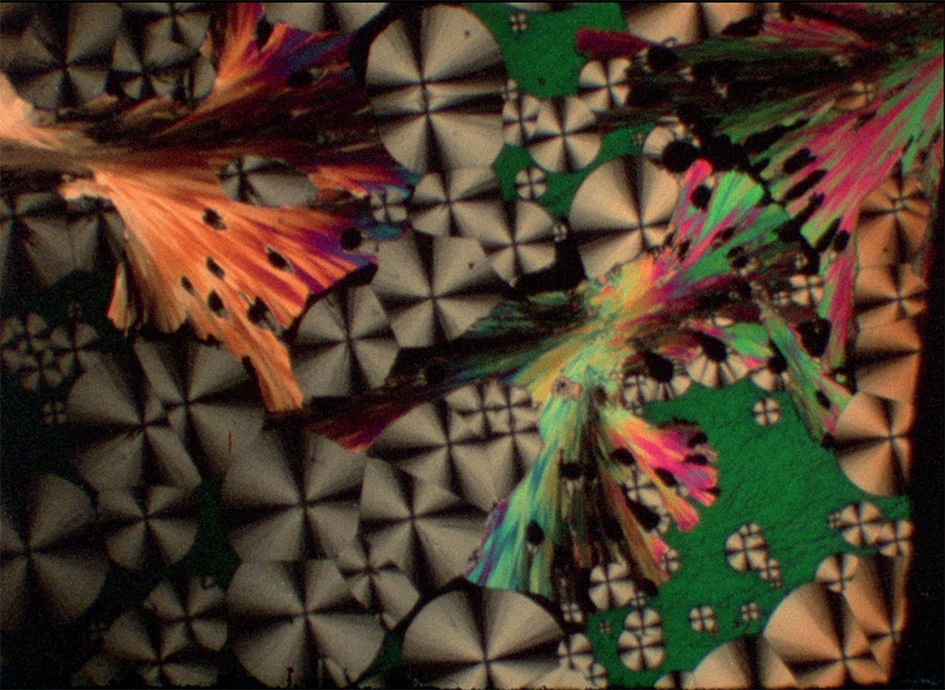Jean Painlevé
Transition de phase dans les cristaux liquides
15 Sep - 03 Nov 2018
JEAN PAINLEVÉ
Transition de phase dans les cristaux liquides
15 September - 3 November 2018
In collaboration with Les Archives Jean Painlevé, we are pleased to present «Phase transition in liquid crystals» a film by Jean Painlevé (1978). One of his latest film and probably the most abstract. Jean Painlevé (1902-1989) was led to film the living world by «the profound beauty of nature in its colours and shapes»; but also, he admitted, by the fact that he drew very badly. As a student in the laboratory of comparative anatomy at the Sorbonne, he became fascinated both by microphotography and by scientific cinema as a modern, efficient means of recording movement. This initially scientific approach led him to discover «things nobody else had seen». Scientific cinema was the instrument that enabled him to share his discoveries by rendering the invisible visible: opposed to traditional teaching, he saw cinema as a decisive vector for generating awareness, and ensured viewer interest by his attentiveness to aesthetics and rhythm, and the anecdotes and shafts of wit that accompanied his message. It was this injection of subjectivity into the scientific that gave a poetic dimension to his work. Since his time at the Sorbonne he had been close to the Surrealists, although more so to Yvan Goll, who posited a causal relationship between Science and Art, than to André Breton, for whom the two were inherently antagonistic. Painlevé was also closely connected to the artists who enlivened the Paris scene in the 1920s, among them Fernand Léger and Alexander Calder. In the late 60s, Jean Painlevé met a young scientist specialized in liquid crystals. Throughout the 70s he filmed his research with a high-speed camera and a photographic microscope. From the 2 hours shot he extracted a 7 minutes film. An original soundtrack by François de Roubaix - an autodidact music maker and cult film music composer - goes along this fascinating ballet of light and colors. The film credits detail briefly the development of liquid crystals. When the state of some liquids are modified such as their temperature or pressure, their properties are altered and they act like crystal. In the microscope, the liquid crystals go from darkness to transparency through an amount of extraordinary colours.
Transition de phase dans les cristaux liquides
15 September - 3 November 2018
In collaboration with Les Archives Jean Painlevé, we are pleased to present «Phase transition in liquid crystals» a film by Jean Painlevé (1978). One of his latest film and probably the most abstract. Jean Painlevé (1902-1989) was led to film the living world by «the profound beauty of nature in its colours and shapes»; but also, he admitted, by the fact that he drew very badly. As a student in the laboratory of comparative anatomy at the Sorbonne, he became fascinated both by microphotography and by scientific cinema as a modern, efficient means of recording movement. This initially scientific approach led him to discover «things nobody else had seen». Scientific cinema was the instrument that enabled him to share his discoveries by rendering the invisible visible: opposed to traditional teaching, he saw cinema as a decisive vector for generating awareness, and ensured viewer interest by his attentiveness to aesthetics and rhythm, and the anecdotes and shafts of wit that accompanied his message. It was this injection of subjectivity into the scientific that gave a poetic dimension to his work. Since his time at the Sorbonne he had been close to the Surrealists, although more so to Yvan Goll, who posited a causal relationship between Science and Art, than to André Breton, for whom the two were inherently antagonistic. Painlevé was also closely connected to the artists who enlivened the Paris scene in the 1920s, among them Fernand Léger and Alexander Calder. In the late 60s, Jean Painlevé met a young scientist specialized in liquid crystals. Throughout the 70s he filmed his research with a high-speed camera and a photographic microscope. From the 2 hours shot he extracted a 7 minutes film. An original soundtrack by François de Roubaix - an autodidact music maker and cult film music composer - goes along this fascinating ballet of light and colors. The film credits detail briefly the development of liquid crystals. When the state of some liquids are modified such as their temperature or pressure, their properties are altered and they act like crystal. In the microscope, the liquid crystals go from darkness to transparency through an amount of extraordinary colours.

